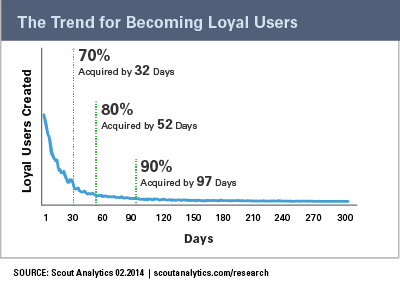Consider the first ninety days of a customer’s subscription. How much customer success can you predict based on that period? How much renewal risk gets created? More than you might think, as it turns out.
In the subscription economy, renewal revenues are driven by customer usage. For example, if a customer overestimated their needs initially and purchased too many users (or some other measure of use), they’ll want to course correct at renewal time and get in line with their actual historic use.
So why are the first ninety days so critical to customer success and renewal revenues? The answer is simple: user adoption equates to higher renewal revenues, and most loyal users are created in the first ninety days.
What’s a loyal user? It’s an individual who uses a product often enough that they become dependent on it. That usage pattern varies by product—with different products designed to be used daily, weekly, monthly, or at some other interval—and that “loyal” usage pattern can also vary by rate plan or user role. But in the end, any given user role and associated rate plan will have an expected usage frequency that can be defined as characteristic of a loyal user.
This is where the 90/10 rule of adoption and customer success comes in: based on our analysis across many different subscription companies, we’ve found that if an individual user doesn’t become loyal within ninety days of provisioning, there’s typically only a ten percent chance that they ever will.
Our analysis tracked cohorts of subscription renewals for an entire year, where the loyal users during the subscription term were classified by the number of days to become loyal users. In fact, the first thirty days produced the highest volume of loyal users, followed by the next thirty and then the next thirty.
The chart to the right for one such case shows a typical relationship between on-boarding and adoption to create loyal users, showing how many loyal users are created by day after provisioning. Note the very rapid decay. Arguably, the first thirty days are the most crucial.
If you think about it, the 90/10 statistic maps to common sense. Both the company and the customer are most energized to work together after closing the initial contract. Both sides have completed planning and the expectations have been set. But then comes the difficult part: delivering against expectations. Ninety days is enough time to vet through all the on-boarding needs and foster adoption for each user. In the B2B world, that’s a full quarter of financial reporting—and let’s face it, customers want to see results.
The Implication
In the subscription economy, managing adoption is managing user success, and user success leads to customer success.
Many organizations have good on-boarding tasks for provisioning and training new users. However, on-boarding can be a checklist activity, and some companies assume users will know where to take it from there. In other words, they assume users will see the value and start using the products as expected—but the truth is that many users don’t know how to adopt a new product into their processes.
User success via adoption should be treated as a distinct activity, and companies need to develop a means to track it—as well as a process to intervene to ensure that adoption takes hold. The ability to track and understand usage data is the key to revenue and profit growth in the subscription economy.






